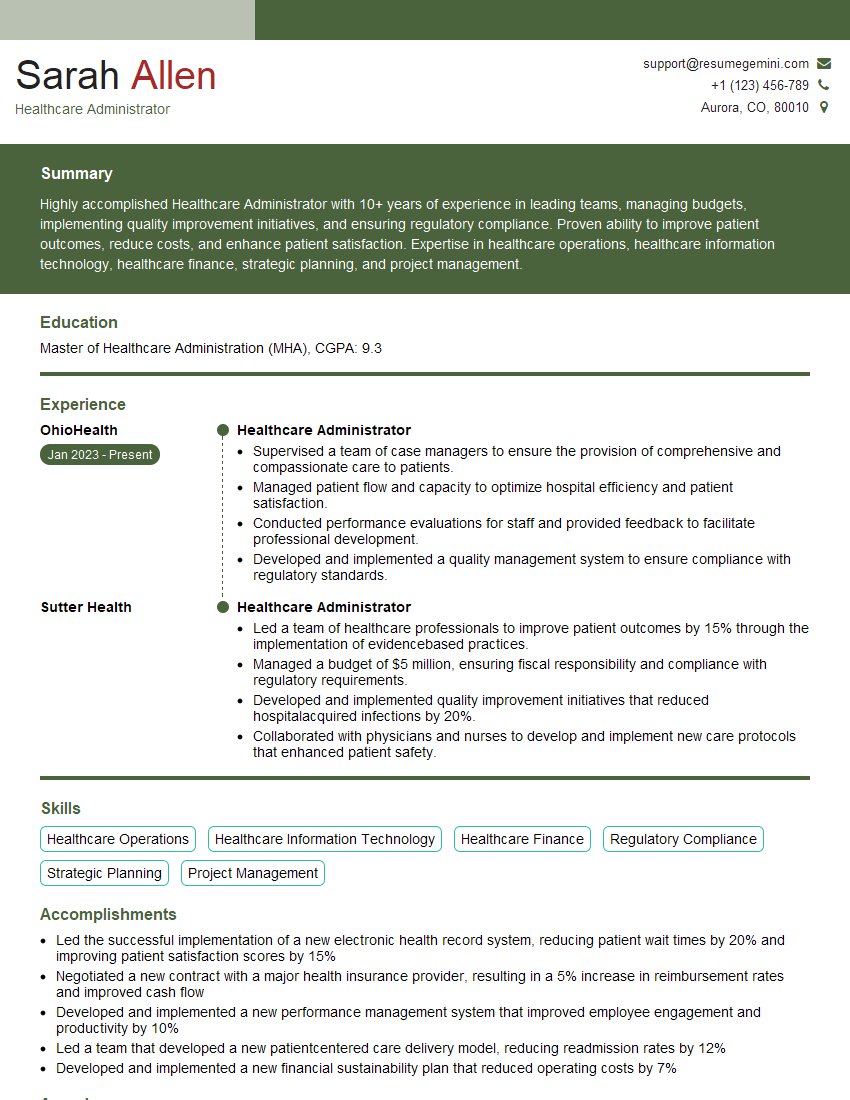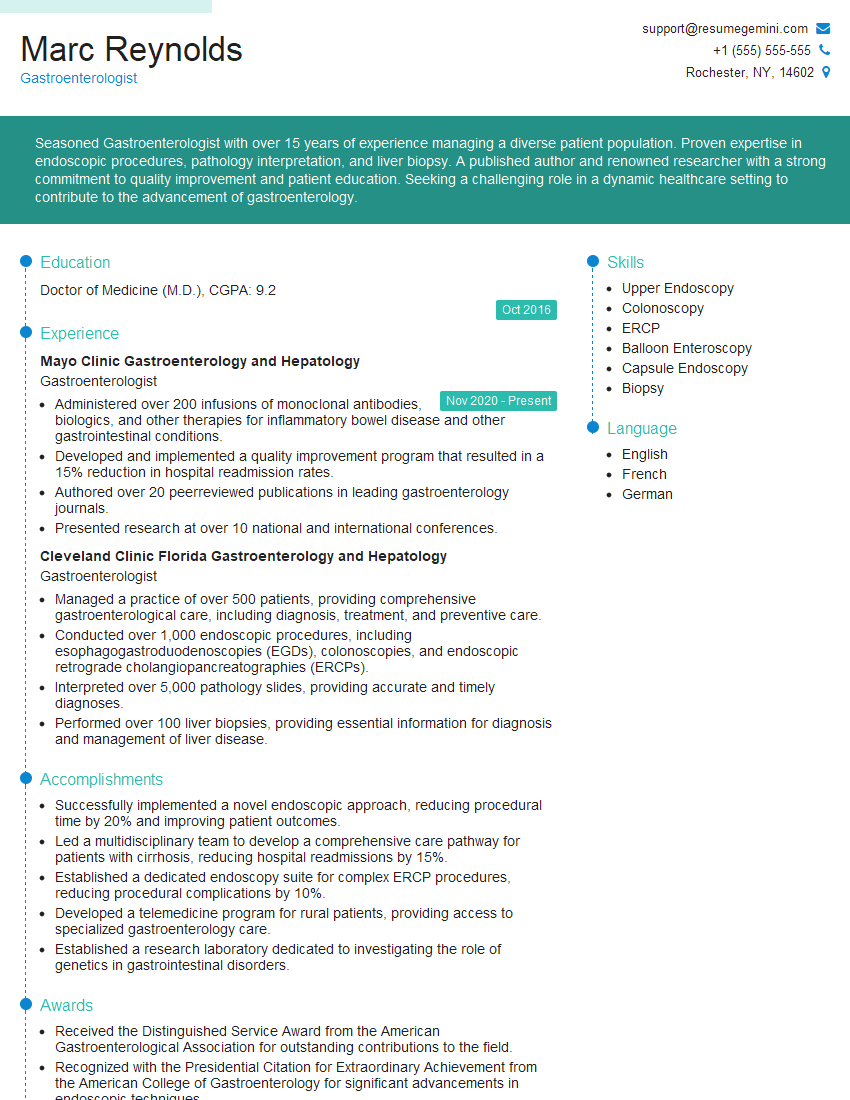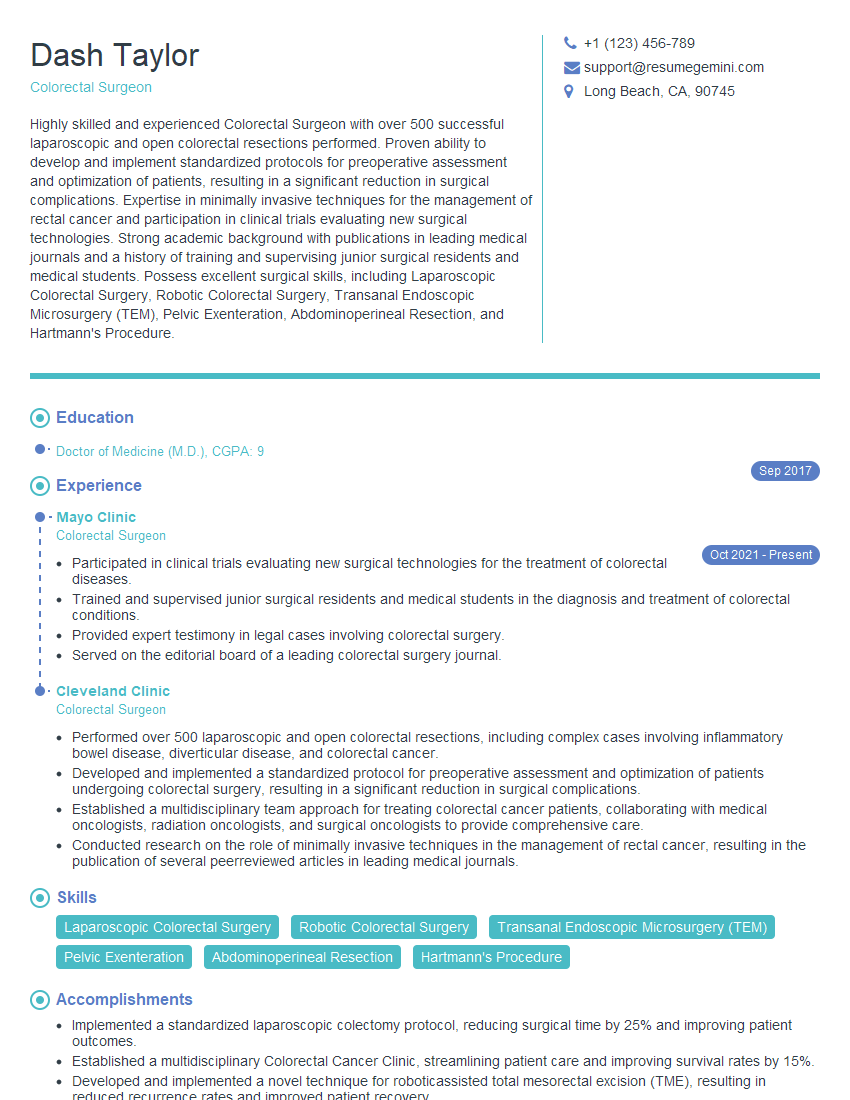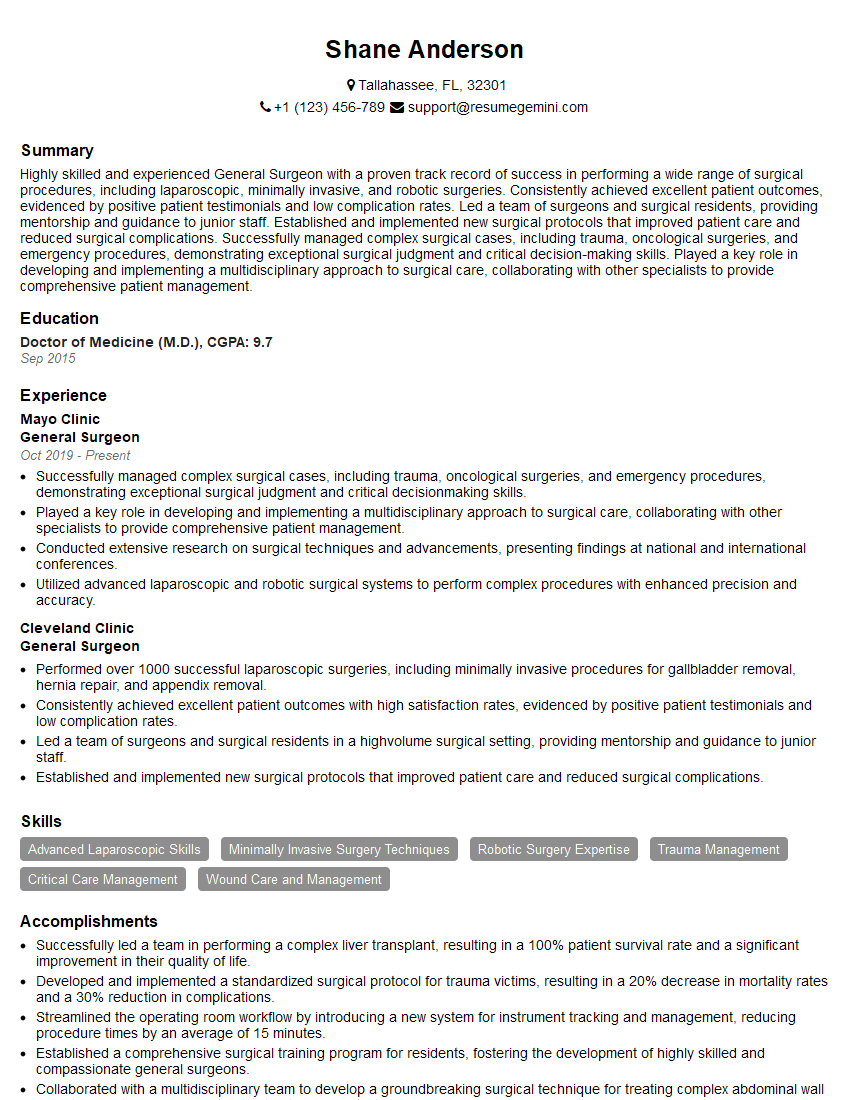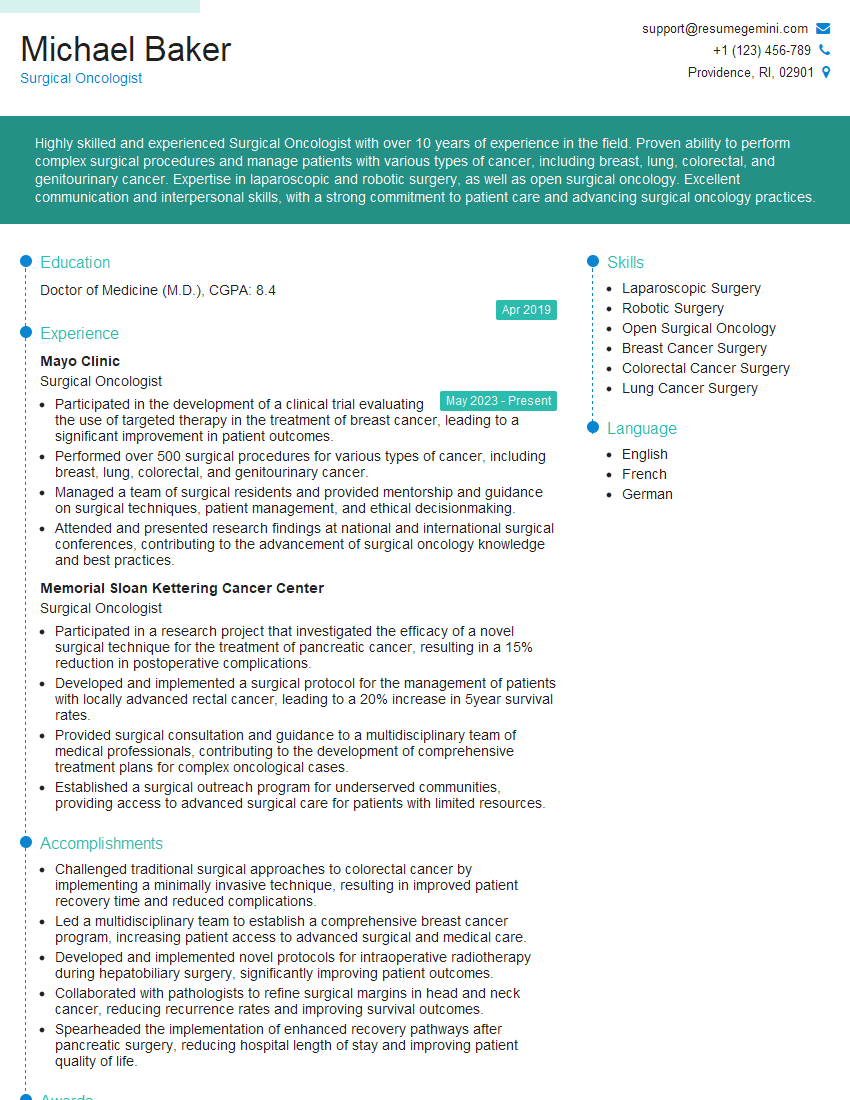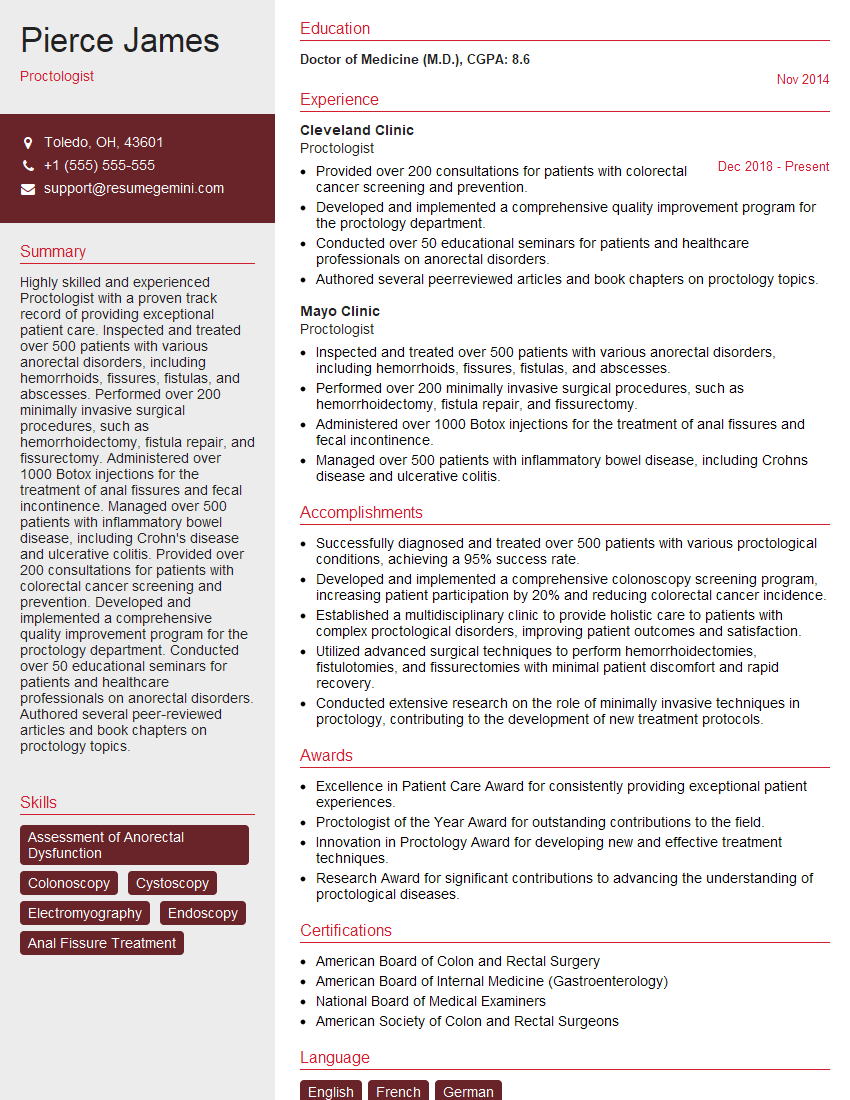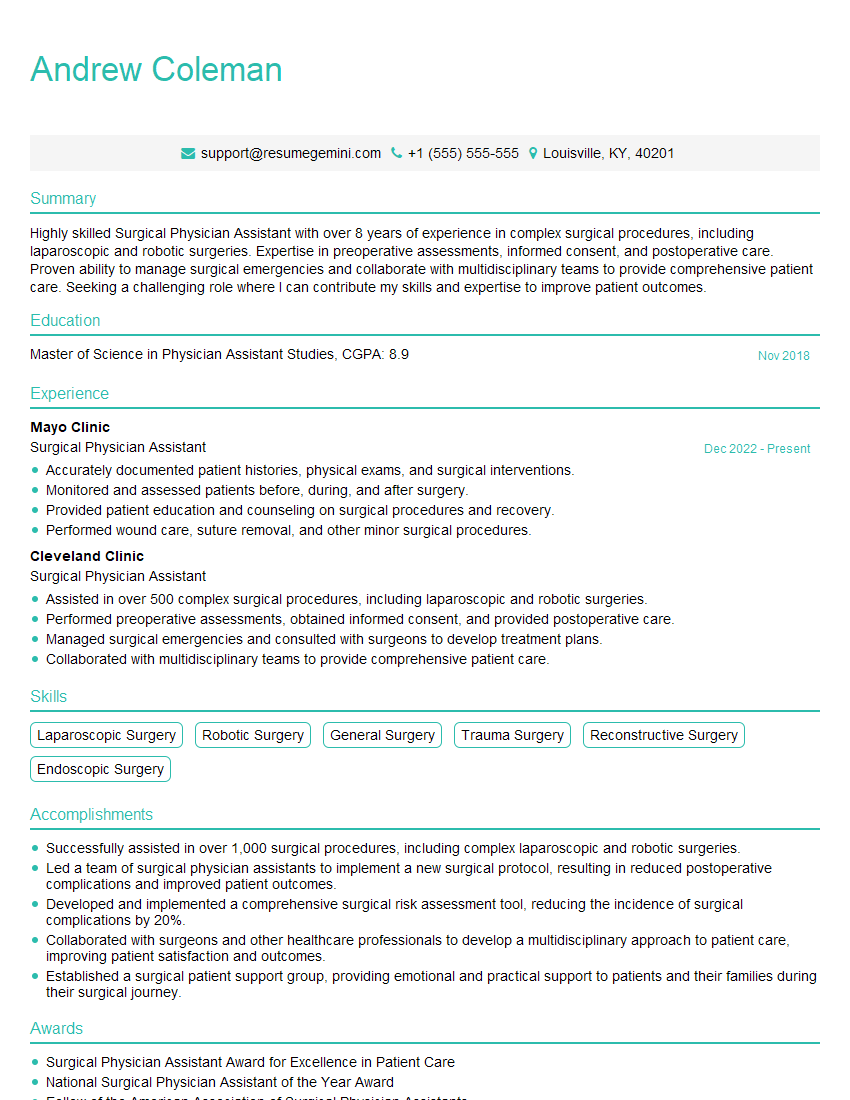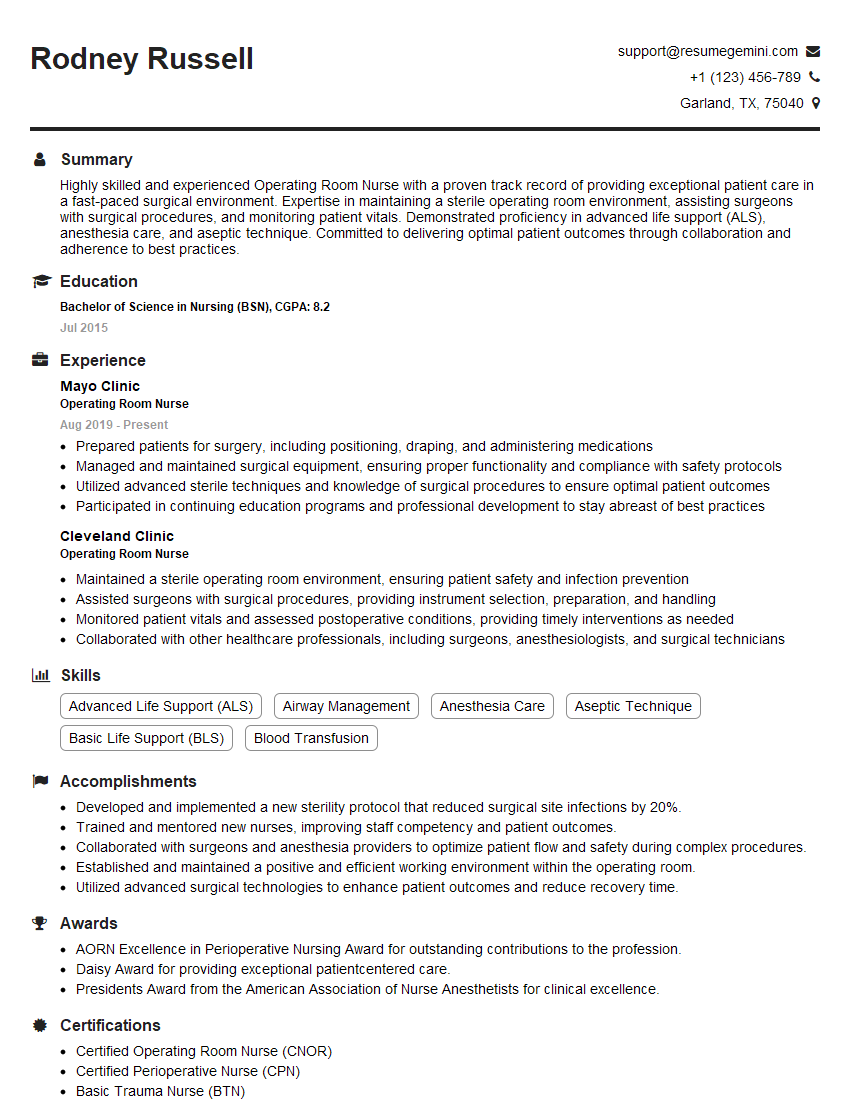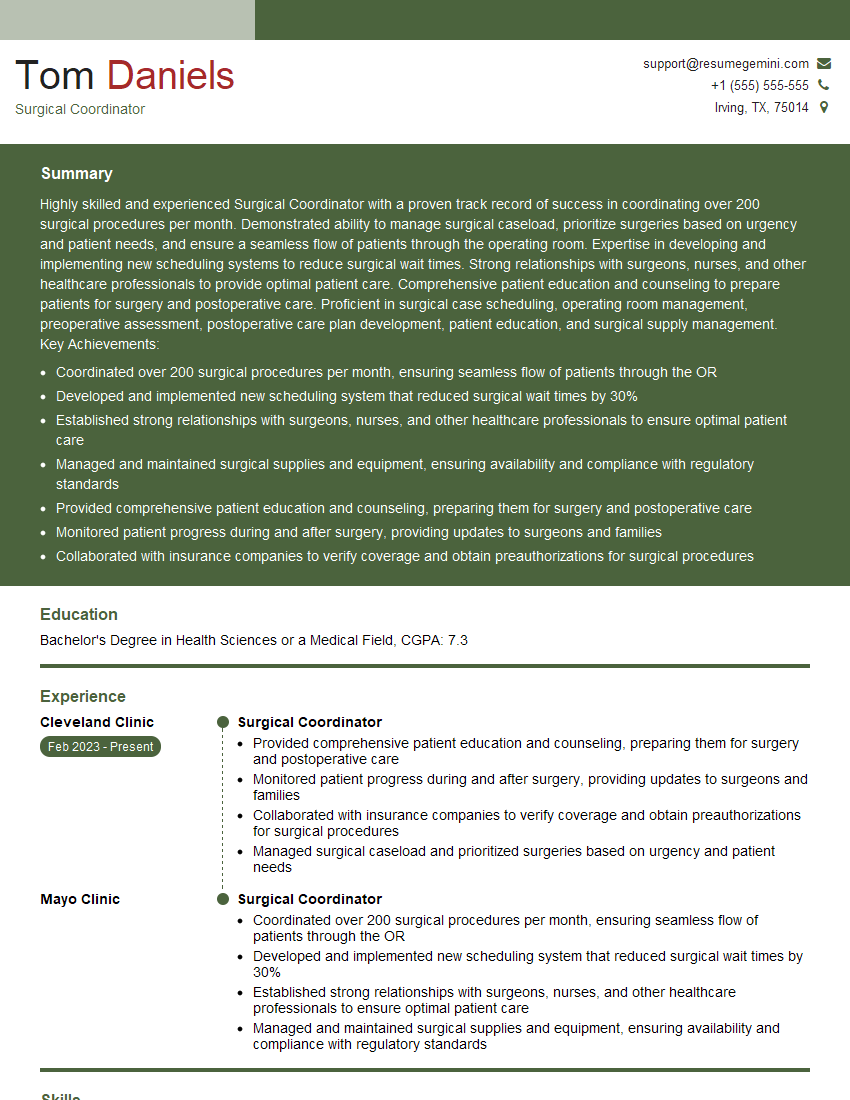Preparation is the key to success in any interview. In this post, we’ll explore crucial Stapled Hemorrhoidopexy interview questions and equip you with strategies to craft impactful answers. Whether you’re a beginner or a pro, these tips will elevate your preparation.
Questions Asked in Stapled Hemorrhoidopexy Interview
Q 1. Describe the indications and contraindications for Stapled Hemorrhoidopexy (PPH).
Stapled hemorrhoidopexy (PPH) is indicated for patients with second-, third-, and fourth-degree hemorrhoids that haven’t responded to conservative management. It’s a minimally invasive procedure ideal for patients with significant prolapse and bleeding.
Contraindications include:
- Severe underlying medical conditions that increase surgical risk (e.g., severe heart or lung disease).
- Active anorectal infection.
- Significant rectal stenosis or other significant rectal pathology.
- Pregnancy.
- Patients with a history of radiation therapy to the pelvis.
- Severe inflammatory bowel disease.
Careful patient selection is crucial for optimal outcomes. For example, a patient with significant comorbidities might be a poor candidate, while a younger, otherwise healthy individual with symptomatic prolapsing hemorrhoids would be a good candidate. We always perform a thorough rectal examination to assess the severity and type of hemorrhoids.
Q 2. Explain the surgical technique of Stapled Hemorrhoidopexy in detail.
The PPH procedure involves the use of a circular stapler to resect the prolapsing hemorrhoidal tissue above the dentate line. This reduces the blood supply to the hemorrhoids and results in shrinkage.
- Preparation: The patient is positioned in the lithotomy position. The rectum is prepped and draped.
- Anoscopy: An anoscope is used to visualize the hemorrhoids.
- Hemorrhoidal Resection: The circular stapler is inserted transanally. The hemorrhoidal tissue is identified and secured by the stapler’s anvil within the anal canal. The circular stapler then resections the prolapsing tissue, creating a line of staples above the dentate line.
- Staple Removal (Optional): In some cases, the staples may be removed a few days or weeks post-operatively. The choice depends on surgeon preference and patient factors.
- Closure: The procedure is complete. The patient is monitored for any complications.
The entire procedure is typically performed under general or spinal anesthesia and usually takes about 30-45 minutes. The key is precise placement of the stapler to avoid injury to the anal sphincter.
Q 3. What are the potential complications associated with Stapled Hemorrhoidopexy?
While generally safe, PPH can have potential complications, including:
- Postoperative Pain: This is common and usually managed with analgesics. Severe pain is less frequent but should be addressed promptly.
- Bleeding: Minor bleeding is possible. Significant bleeding requires immediate attention.
- Rectal Stenosis: Narrowing of the anal canal can occur, though this is less common with proper technique.
- Infection: Infections can occur and may need antibiotic treatment.
- Transanal Exsanguination: Though rare, it’s a serious complication requiring immediate intervention.
- Recurrence: Although less frequent than with other methods, recurrence is still possible.
- Staple-related complications: Issues such as staple slippage, incomplete resection, or staple infection are possible.
Preoperative counseling about potential complications is crucial to manage patient expectations.
Q 4. How do you manage postoperative pain and bleeding after Stapled Hemorrhoidopexy?
Postoperative pain management is critical for patient comfort and recovery. We usually begin with oral analgesics such as opioids (for the first few days) and non-steroidal anti-inflammatory drugs (NSAIDs) to control pain. Regular pain assessments are vital. In case of severe pain, stronger analgesics or nerve blocks might be considered. Bleeding is less common with PPH than with other methods, but if it does occur, careful observation and potentially endoscopic measures are used to manage it.
For example, a patient might receive a combination of oxycodone and acetaminophen for the first 24-48 hours followed by a transition to ibuprofen or naproxen.
Q 5. Compare and contrast Stapled Hemorrhoidopexy with other hemorrhoid treatment methods.
PPH offers several advantages over other hemorrhoid treatment methods. Compared to conventional hemorrhoidectomy, it’s generally associated with less postoperative pain and faster recovery time. However, it might not be suitable for all patients, particularly those with internal hemorrhoids without prolapse. Other methods like rubber band ligation are less invasive but may require multiple sessions. Infrared coagulation targets smaller hemorrhoids but is less effective for larger ones. Sclerotherapy is also less invasive but tends to have lower success rates.
Here’s a table summarizing the key differences:
| Method | Invasiveness | Recovery Time | Pain Level | Effectiveness |
|---|---|---|---|---|
| Stapled Hemorrhoidopexy | Minimally Invasive | Faster | Lower | High for prolapsing hemorrhoids |
| Hemorrhoidectomy | More Invasive | Slower | Higher | High |
| Rubber Band Ligation | Minimally Invasive | Moderate | Low to Moderate | Moderate |
| Infrared Coagulation | Minimally Invasive | Fast | Low | Low to Moderate |
| Sclerotherapy | Minimally Invasive | Fast | Low | Low |
The best method depends on the individual patient and the nature of their hemorrhoids. A detailed assessment is needed to determine the most suitable approach.
Q 6. Discuss the patient selection criteria for Stapled Hemorrhoidopexy.
Patient selection is crucial for PPH. Ideal candidates typically have:
- Second-, third-, or fourth-degree hemorrhoids with significant prolapse.
- Significant bleeding.
- Failure of conservative management.
- No significant contraindications (such as severe medical conditions, active infections, or significant rectal pathology).
We thoroughly evaluate each patient to ensure they meet the criteria. This often includes a detailed medical history, physical examination, and possibly additional tests like anoscopy or proctoscopy to assess the severity and location of the hemorrhoids.
For instance, a patient with mild internal hemorrhoids and minimal symptoms would be a poor candidate for PPH, whereas a patient with significant prolapsing hemorrhoids and significant bleeding would be an ideal candidate.
Q 7. What are the long-term outcomes and recurrence rates associated with Stapled Hemorrhoidopexy?
Long-term outcomes of PPH are generally favorable. Most patients experience significant improvement in symptoms, including reduction in bleeding and prolapse. However, recurrence rates, though lower than with other procedures, are still possible. The long-term recurrence rate is typically around 5-15% at five years, and further increase in recurrence is possible after 10 years. Various factors like the surgeon’s experience and the patient’s adherence to post-operative instructions can affect the outcome and recurrence rates.
Regular follow-up appointments are crucial to monitor for any complications or recurrence and allow for timely intervention if needed.
Q 8. Describe your experience with managing complications such as rectal bleeding or stenosis after PPH.
Managing complications after PPH (Prolapse and Hemorrhoid Procedure), such as rectal bleeding and stenosis, requires a multi-faceted approach. Rectal bleeding, usually minor and self-limiting, is addressed with close monitoring, dietary modifications (high-fiber diet to avoid straining), and stool softeners. In cases of persistent or significant bleeding, endoscopic evaluation may be necessary to rule out other causes and to potentially cauterize bleeding vessels. Stenosis, or narrowing of the anal canal, is a more serious complication. It can cause significant constipation and pain. Mild stenosis may improve with conservative management, including bowel regimens and regular anal dilatation. However, more significant stenosis may necessitate surgical intervention, possibly requiring anal dilation under anesthesia or even surgical revision.
For instance, I recently managed a patient who presented with persistent bleeding after PPH. Careful observation and dietary changes resolved the issue within a week. However, another patient required endoscopic examination to identify and cauterize a small bleeding vessel. Early identification and appropriate management are crucial in preventing long-term complications.
Q 9. How do you counsel patients regarding the risks and benefits of Stapled Hemorrhoidopexy?
Counseling patients about Stapled Hemorrhoidopexy involves a balanced discussion of risks and benefits. I begin by explaining the procedure in simple terms, emphasizing that it’s designed to reduce hemorrhoidal prolapse and bleeding by surgically repositioning the hemorrhoidal tissue. We then discuss the potential benefits, which include shorter recovery time compared to traditional hemorrhoidectomy, less postoperative pain, and a quicker return to normal activities. It’s important to emphasize that this is not a cure for hemorrhoids and recurrence is possible.
The risks are also thoroughly discussed, including the possibility of rectal bleeding (usually mild and self-limiting), stenosis, infection, and, in rare cases, more serious complications such as perforation. I use clear, non-medical jargon to explain these risks, providing real-life examples where appropriate, and answer all their questions openly and honestly. Informed consent is paramount. We discuss alternative treatments as well, allowing the patient to make an informed decision based on their individual circumstances and preferences.
Q 10. What are the advantages and disadvantages of Stapled Hemorrhoidopexy compared to traditional hemorrhoidectomy?
Stapled Hemorrhoidopexy offers several advantages over traditional hemorrhoidectomy (such as Milligan-Morgan). The most significant advantages include reduced postoperative pain, shorter hospital stay (often outpatient), faster recovery, and a quicker return to normal activities. This is because PPH involves less tissue removal and less disruption to the anal canal compared to hemorrhoidectomy.
However, Stapled Hemorrhoidopexy has some disadvantages. The risk of recurrence is higher than with traditional hemorrhoidectomy, though recent studies suggest this difference might be narrowing. There’s also a higher risk of complications such as stenosis, though these are generally manageable. Furthermore, PPH is not suitable for all patients – it requires a specific type of hemorrhoidal prolapse and may not be appropriate for those with certain medical conditions. Choosing between the two procedures depends on the individual patient’s clinical presentation, comorbidities, and preferences.
Q 11. Explain your approach to diagnosing and managing postoperative infections after Stapled Hemorrhoidopexy.
Postoperative infection after Stapled Hemorrhoidopexy is relatively rare but requires prompt diagnosis and management. The first step is clinical assessment, which may include physical examination to assess for signs of infection such as localized pain, swelling, redness, and purulent discharge. Laboratory tests, such as a complete blood count (CBC), may be ordered to detect signs of infection. If an infection is suspected, imaging studies (e.g., CT scan) may be necessary to determine the extent of the infection.
Treatment typically involves broad-spectrum antibiotics, targeted based on culture results if available. Local wound care, including cleaning and dressing changes, is important. In severe cases, surgical drainage may be necessary. Regular monitoring is crucial to ensure the infection resolves effectively and prevent further complications. Early identification and appropriate antibiotic use usually lead to a successful outcome, minimizing potential morbidity.
Q 12. Describe your experience using different types of staplers for PPH.
My experience encompasses the use of various staplers approved for PPH. While specific model names may vary based on manufacturer, the principles remain consistent. Key aspects I consider include the stapler’s ease of use, its ability to provide secure and consistent staple placement, and its overall reliability. I find that proper training and familiarity with the device are critical for minimizing complications. Regular maintenance and adherence to manufacturer’s instructions are vital for ensuring safe and effective use. Careful attention to the patient’s anatomy during the procedure is equally crucial to optimize outcomes. For example, I’ve used both circular and linear staplers, each with slight variations in technique. The choice depends on individual patient anatomy and surgeon preference.
Q 13. How do you assess the effectiveness of Stapled Hemorrhoidopexy in your patients?
Assessing the effectiveness of Stapled Hemorrhoidopexy involves a multi-pronged approach. Postoperative follow-up is crucial. Patients are typically assessed at regular intervals to evaluate their symptoms, assess for any complications, and evaluate their overall quality of life. This involves subjective measures like patient-reported outcome measures (PROMs) capturing pain, bleeding, and bowel function. Objective measures include physical examination to assess for recurrence, stenosis, or other complications.
Long-term follow-up is also essential to determine the long-term success rate and durability of the procedure. Anorectal manometry or other imaging techniques may be used in selected cases to assess functional outcomes. Data collected from these assessments is vital for continuous improvement and to refine surgical techniques to ensure optimal patient outcomes. I routinely analyze this data to assess my own performance and look for trends that may inform my approach to future cases.
Q 14. What are the key differences between Stapled Hemorrhoidopexy and Milligan-Morgan hemorrhoidectomy?
The key difference between Stapled Hemorrhoidopexy and Milligan-Morgan hemorrhoidectomy lies in their surgical approach. Milligan-Morgan hemorrhoidectomy involves the excision of hemorrhoidal tissue, resulting in open wounds that need to heal. This leads to more postoperative pain, longer recovery time, and a greater chance of complications like infection and anal stenosis. In contrast, Stapled Hemorrhoidopexy uses a circular stapler to resect and reposition the prolapsed hemorrhoidal tissue, creating less trauma to the anal canal. This results in less postoperative pain, faster recovery, and a quicker return to normal activities. It is crucial to understand that while both procedures effectively treat hemorrhoids, they differ significantly in their surgical technique and patient recovery experience. The choice of procedure is guided by patient factors, surgeon preference, and specific clinical scenario.
Q 15. Discuss the role of preoperative bowel preparation in Stapled Hemorrhoidopexy.
Preoperative bowel preparation for Stapled Hemorrhoidopexy (PPH) aims to minimize the risk of fecal contamination during surgery and promote optimal healing post-operation. It’s crucial for minimizing the chances of infection and ensuring a clean surgical field. The preparation usually involves a bowel cleanse using polyethylene glycol (PEG) solutions or similar preparations. This is a clear liquid diet and oral laxatives for a day or two before surgery. The specific regimen is tailored to the patient’s individual needs and health status. For example, a patient with pre-existing bowel conditions may require a modified approach. The goal is to achieve a clean bowel without excessive dehydration or electrolyte imbalances.
It’s important to note that overly aggressive bowel preparation can sometimes lead to complications, such as dehydration and electrolyte disturbances. Therefore, a balanced approach is crucial, carefully considering the benefits and potential risks. We discuss the bowel preparation plan extensively with each patient beforehand, addressing any concerns and ensuring they understand the process.
Career Expert Tips:
- Ace those interviews! Prepare effectively by reviewing the Top 50 Most Common Interview Questions on ResumeGemini.
- Navigate your job search with confidence! Explore a wide range of Career Tips on ResumeGemini. Learn about common challenges and recommendations to overcome them.
- Craft the perfect resume! Master the Art of Resume Writing with ResumeGemini’s guide. Showcase your unique qualifications and achievements effectively.
- Don’t miss out on holiday savings! Build your dream resume with ResumeGemini’s ATS optimized templates.
Q 16. How do you prevent and manage complications like fecal incontinence or anal stricture after PPH?
Fecal incontinence and anal stricture are potential, though thankfully uncommon, complications following PPH. Prevention is key. Careful surgical technique, avoiding excessive dissection and ensuring precise stapling are paramount. We meticulously identify and preserve the anorectal ring’s integrity during the procedure. Post-operatively, early mobilization and a balanced diet, including a high-fiber intake, aid in preventing complications. Regular follow-up appointments allow for prompt identification and management of any potential issues.
If anal stricture develops, it’s often managed with anal dilatation, a procedure that gradually stretches the anal canal. For fecal incontinence, biofeedback therapy can be helpful, training patients to regain control over their bowel movements. In severe cases, surgical repair might be necessary, but thankfully this is rare with proper technique and postoperative care.
Q 17. What are your preferred methods for assessing postoperative hemorrhoidal bleeding?
Assessing postoperative hemorrhoidal bleeding after PPH involves a multi-pronged approach. Initially, close observation during the immediate postoperative period is essential. This includes monitoring for bleeding on the patient’s pads and assessing stool for blood. Digital rectal examination is conducted cautiously to check for any evidence of active bleeding or abnormalities. If bleeding persists or is significant, proctoscopy (examination of the rectum with a scope) may be performed to visualize the site of bleeding and determine its severity.
In situations of substantial or persistent bleeding, angiography may be required for targeted management. This is rare in properly executed PPH, however. We maintain open communication with patients, encouraging them to promptly report any concerns about bleeding or other postoperative symptoms.
Q 18. What imaging modalities do you utilize to evaluate patients before and after Stapled Hemorrhoidopexy?
While imaging isn’t routinely used before PPH, it may be considered in certain cases to rule out other pathologies. A colonoscopy, for instance, may be useful if there are concerns about colonic disease. Postoperatively, imaging is rarely necessary unless there are complications suggesting potential issues. A proctoscopy, as mentioned, can visualize the anal canal and rectum. However, typically, a clinical examination and patient history suffice for follow-up care after a successful PPH procedure.
Q 19. Describe your experience with the use of minimally invasive techniques in hemorrhoid treatment.
My experience with minimally invasive techniques in hemorrhoid treatment has been overwhelmingly positive. PPH itself is a minimally invasive procedure, and I’ve witnessed significant benefits for patients – reduced pain, faster recovery times, and excellent functional outcomes. Compared to traditional hemorrhoidectomy, which involves a more extensive surgical approach, PPH has proven to be a game-changer. I’ve seen a marked improvement in patient satisfaction and a reduction in complications such as significant bleeding and post-operative pain.
Further, I also utilize rubber band ligation for smaller hemorrhoids or as an adjunct therapy in some cases. This method is less invasive and often suitable for milder cases. The choice between PPH and other minimally invasive techniques depends on the patient’s individual presentation and clinical assessment.
Q 20. How do you adapt your surgical technique for patients with particular anatomical variations?
Surgical technique adaptation for patients with anatomical variations is crucial. For example, a patient with a low-lying anorectal ring might require a modification in the placement of the staples to avoid potential injury. Similarly, patients with significant internal hemorrhoids might benefit from a different approach than those with predominantly external hemorrhoids. Preoperative assessment, including careful anoscopy and digital rectal examination, is crucial in identifying these variations.
I adapt my technique based on these individual assessments, making sure to prioritize patient safety and optimal surgical outcomes. Every patient’s anatomy presents unique challenges and opportunities, and surgical expertise lies in understanding and adapting to those specifics.
Q 21. What are the ethical considerations in the selection of patients for Stapled Hemorrhoidopexy?
Ethical considerations in patient selection for PPH center around ensuring it’s the most appropriate procedure for the individual. The patient must be fully informed about the risks and benefits of PPH, as well as alternative treatment options. Informed consent is paramount. We should not proceed with PPH if a patient’s medical history, such as severe cardiovascular disease or coagulopathy, presents significant surgical risks. Furthermore, we must carefully assess the patient’s understanding of the procedure and their willingness to comply with postoperative instructions.
Open communication and shared decision-making are essential to ensure ethical practice. The goal is to provide the best possible care, aligning the treatment plan with the patient’s needs and preferences within the confines of sound medical judgment.
Q 22. How do you handle patients with unexpected intraoperative findings during Stapled Hemorrhoidopexy?
Unexpected intraoperative findings during stapled hemorrhoidopexy are not uncommon. These can range from unexpectedly large hemorrhoids, significant internal anal sphincter involvement, or the presence of significant inflammation or infection. My approach is systematic and prioritizes patient safety. First, I thoroughly assess the situation. If the finding significantly alters the surgical plan, a detailed discussion with the patient (or their surrogate) is essential. For example, if the hemorrhoids are significantly larger than anticipated, I might need to adjust the staple placement or consider a different surgical technique, such as a conventional hemorrhoidectomy, to ensure complete resection and avoid complications. If severe inflammation or infection is present, the procedure may need to be postponed to allow for treatment of the infection, preventing potential complications such as abscess formation or sepsis. Documentation of all findings, including any alterations to the original surgical plan, is crucial for thorough record-keeping and potential future reference.
In cases where I encounter significant internal anal sphincter involvement, I carefully assess the extent of involvement to avoid excessive resection that could lead to anal incontinence. Techniques like selective resection or preservation of a significant portion of the sphincter are prioritized. Careful hemostasis is paramount in all cases, ensuring minimal bleeding during and after surgery. Ultimately, a flexible and adaptable approach, always prioritizing patient safety, is essential in handling intraoperative surprises.
Q 23. Explain your approach to postoperative follow-up care for patients undergoing Stapled Hemorrhoidopexy.
Postoperative follow-up care for stapled hemorrhoidopexy is critical to ensure optimal healing and minimize potential complications. The immediate post-operative period focuses on pain management. This usually involves analgesics and stool softeners to reduce straining and pain during bowel movements. Patients are educated on proper hygiene, including regular sitz baths and avoidance of harsh cleansers. Early mobilization is encouraged to reduce the risk of complications like thromboembolism. Follow-up appointments are scheduled regularly, usually within a week and then again at 1 month, 3 months, and 6 months post-operatively. During these visits, I assess for pain, bleeding, wound healing, and any signs of infection or other complications. We discuss any issues the patient might be experiencing and adjust management accordingly. For instance, if a patient is struggling with severe constipation despite stool softeners, we may explore other options like laxatives or dietary adjustments. The longer-term follow-up focuses on assessing long-term outcomes, including symptom relief and recurrence rates.
Q 24. How do you stay current with the latest advancements and research in Stapled Hemorrhoidopexy?
Staying current in the field of Stapled Hemorrhoidopexy requires a multi-pronged approach. I actively participate in continuing medical education (CME) courses and conferences specifically focused on colorectal surgery. These events often feature lectures and workshops on the latest techniques, technological advancements, and research findings. I regularly review peer-reviewed journals such as Diseases of the Colon & Rectum and Surgical Endoscopy, focusing on articles related to stapled hemorrhoidopexy, including those exploring new techniques, comparing outcomes across different approaches, and assessing the long-term efficacy of the procedure. Membership in professional organizations like the American Society of Colon and Rectal Surgeons (ASCRS) provides access to educational resources, publications, and networking opportunities with colleagues who are experts in the field. Furthermore, I actively participate in case discussions and journal clubs within my hospital, allowing for collaborative learning and sharing of experiences with my peers.
Q 25. Discuss your experience with patient education and counseling before and after Stapled Hemorrhoidopexy.
Patient education and counseling are fundamental to the success of stapled hemorrhoidopexy. Before surgery, I thoroughly explain the procedure, including its benefits, risks, and potential complications. I use clear, simple language and visual aids, such as diagrams or videos, to ensure patients fully understand what to expect. I answer all their questions patiently and honestly, addressing any concerns or anxieties they may have. This comprehensive pre-operative counseling helps manage patient expectations and ensures informed consent. After surgery, education focuses on post-operative care, including pain management, hygiene, dietary advice, and activity restrictions. We discuss potential complications and how to recognize them, empowering patients to be active participants in their recovery. I provide patients with written instructions and encourage them to contact me with any questions or concerns they may have, reinforcing the importance of communication throughout the recovery process. I always strive to make my patients feel comfortable, confident, and well-informed.
Q 26. How do you document your surgical procedures and outcomes for Stapled Hemorrhoidopexy?
Thorough documentation is essential for quality improvement and legal reasons. My documentation of stapled hemorrhoidopexy procedures follows a standardized format, using our hospital’s electronic health record (EHR) system. This includes detailed preoperative assessment, intraoperative notes (describing the procedure step-by-step, including any unexpected findings and modifications to the plan), postoperative course, and follow-up evaluations. The operative report includes details of the patient’s condition, the type of anesthesia used, the surgical technique employed, including the specific type of stapler used, the number of staples placed, and any complications encountered. Postoperative documentation includes details about pain management, bowel function, bleeding, wound healing, and any other relevant observations. All follow-up appointments are meticulously documented, recording the patient’s progress, any ongoing challenges, and the management strategies implemented. This detailed record-keeping ensures consistency, provides a complete picture of the patient’s journey, and aids in effective communication across healthcare professionals.
Q 27. What are the quality indicators you use to monitor the success rate of Stapled Hemorrhoidopexy?
Monitoring the success rate of Stapled Hemorrhoidopexy relies on several key quality indicators. These include patient-reported outcome measures (PROMs), such as the Wexner incontinence score and the Patient Assessment of Constipation Symptoms (PAC-SYM), to assess symptom relief and quality of life. We also track objective measures like the recurrence rate, defined as the percentage of patients experiencing a return of symptoms requiring further intervention. Other key indicators include the incidence of complications such as bleeding, infection, and anal incontinence. Regular audits of these indicators help identify areas for improvement and ensure adherence to best practices. These data are collected and analyzed on a regular basis to evaluate the effectiveness of our procedures and identify areas where refinements in technique or post-operative care might be beneficial. Ultimately, the aim is to continually improve patient outcomes.
Q 28. Describe a challenging case involving Stapled Hemorrhoidopexy and how you successfully managed it.
One particularly challenging case involved a patient with severe, long-standing hemorrhoids and significant fibrosis. Pre-operative imaging revealed extensive scarring and distortion of the anal canal anatomy, making the standard approach to stapled hemorrhoidopexy potentially risky. The concern was that the fibrosis could compromise staple placement and increase the risk of complications. After a detailed discussion with the patient, we opted for a modified approach. I employed meticulous dissection to carefully identify and mobilize the hemorrhoidal tissue, avoiding excessive traction on the scarred tissue. The staple placement required meticulous precision, with careful attention to avoid perforations. Post-operatively, the patient experienced more significant pain than anticipated, necessitating a longer course of pain management. However, through diligent post-operative management, including regular follow-up, careful wound care, and pain management adjustments, the patient eventually recovered well with excellent long-term results. This case highlighted the importance of flexibility, meticulous technique, and personalized post-operative care in managing complex cases.
Key Topics to Learn for Stapled Hemorrhoidopexy Interview
- Patient Selection Criteria: Understanding the ideal candidate for stapled hemorrhoidopexy, including contraindications and risk factors.
- Surgical Technique: Mastering the steps involved in the procedure, from pre-operative preparation to post-operative care. This includes a thorough understanding of the instrumentation and its proper use.
- Anatomy and Physiology of the Anorectum: A strong grasp of the relevant anatomy and how hemorrhoids develop is crucial for successful surgical planning and execution.
- Complications and Management: Being prepared to discuss potential complications, their management, and preventative strategies. This includes recognizing early signs of complications and implementing appropriate interventions.
- Post-operative Care and Patient Education: Understanding the importance of clear and effective communication with patients regarding post-operative expectations, pain management, and potential complications.
- Comparison with other Hemorrhoid Treatment Methods: Ability to articulate the advantages and disadvantages of stapled hemorrhoidopexy compared to other surgical and non-surgical techniques.
- Long-term Outcomes and Follow-up: Knowledge of expected outcomes, recurrence rates, and the importance of long-term patient follow-up.
- Troubleshooting and Problem-Solving: Being able to anticipate and address potential intraoperative challenges and complications.
Next Steps
Mastering Stapled Hemorrhoidopexy significantly enhances your skillset and opens doors to specialized roles and advanced opportunities within colorectal surgery. A strong understanding of this procedure demonstrates proficiency and commitment to your surgical career. To maximize your job prospects, creating an ATS-friendly resume is paramount. ResumeGemini is a trusted resource that can help you build a professional and impactful resume tailored to showcase your expertise in Stapled Hemorrhoidopexy. Examples of resumes specifically designed for this field are available through ResumeGemini to guide you in highlighting your skills and experience effectively. Take the next step towards your dream career today!
Explore more articles
Users Rating of Our Blogs
Share Your Experience
We value your feedback! Please rate our content and share your thoughts (optional).
What Readers Say About Our Blog
This was kind of a unique content I found around the specialized skills. Very helpful questions and good detailed answers.
Very Helpful blog, thank you Interviewgemini team.
